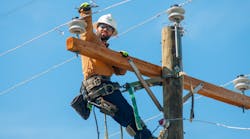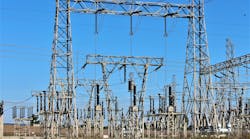Up until 1993, Dixie Electric Membership Cooperative's (DEMCO) right-of-way (R/W) program was on an eight- to nine-year cycle of distribution trimming and did not include a spray program. Budget restraints and the management practices in place at the time caused varied results. Motivated to improve safety and reliability for its customers, DEMCO developed a 10-year management plan adopting a two-year spray program and a five-year trimming cycle.
Due in part to the marshy, swampy environment and the relatively overgrown condition of the R/Ws, DEMCO adopted an aggressive three-pronged approach that included mechanical trimming, herbicides and R/W reclamation. Where feasible, repetitive trimming in R/Ws evolved to tree removal. In transmission R/Ws, DEMCO moved from performing limited side trimming to reclaiming the entire width of the R/W.
In 1999 the program began closer inspection of trees on the edges of the R/W to identify defects or danger trees that could pose a risk of future outages. DEMCO promotes the health of trees that are at the edges of the R/Ws by removing trees that will be severely impacted by trimming. DEMCO believes trees that develop naturally and have naturally pruned crowns are healthier and less likely to cause problems in the future. This sometimes gives the appearance of irregular power line boundaries, but it is more aesthetically pleasing than straight-line geometric shapes.
To gear up for the 10-year plan, DEMCO worked with its tree-trimming contractors to bring in specialized equipment to deal with marshy swampland. About 15% of the seven-parish area is swampland forested with cypress, pond cypress, water tupelo, sweet gum and water oak. To reclaim a R/W in this area, you can't just roll in on rubber tires or back in a chip truck. Before having specialized equipment in 1998, DEMCO cleared these areas manually. The company performed tree removal by hand with the options to leave the logs in the R/W, which could interfere with future maintenance or operating work, or to incur the large expense of carrying logs out of the R/W.
Without the convenience of using equipment on stable ground, DEMCO found new tools and specialized equipment on tracks or pontoons specifically adapted for this environment.
DEMCO tackles its territory with three main types of mowers:
-
The Brontosaurus mower, operated by Boulanger Tree Service, is an excavator with mower in place of the usual bucket.
-
The Fecon mower is mounted on a track hoe.
-
The SlashBuster is mounted on pontoon tracks. The SlashBuster is an excavator-mounted brush-cutting attachment that can handle trees with diameters of 30 inches (76 cm) or more.
One person operates each of these machines, which are not only capable of trimming trees but also can convert the debris into chips.
DEMCO believes in working within nature's guidelines, because natural methods provide long-term benefits to the timber and wildlife resources while providing excellent R/Ws. By removing incompatible species and allowing low-growing plants to develop, DEMCO promotes natural controls through competition.
Beyond natural controls, DEMCO's herbicide program is on a two-year cycle for distribution and three- to four-year cycles for transmission. To a certain extent, the effect of herbicide applications replicates the process of fire that is found in nature. DEMCO continues to try and convert R/Ws to early successional-type plants that are low growing and easily maintained.
DEMCO has an aggressive notification program to communicate with customers about all aspects of the R/W maintenance program through local newspapers, local public meetings and DEMCO's own monthly newspaper. DEMCO looks forward to the opportunity to promote its management practices, and it offers consumers the opportunity to comment and question its practices.
Rural Utility Service's reliability goals are to reduce outage duration to below five hours per consumer per year for all outages including storms. Tree-related outages are one of the largest contributors to outage duration. In 2001, the duration of R/W-related outages reduced one hour, representing an approximately 25% improvement. While still over the goal, DEMCO is making strides to improve reliability.
Compared with previous bids for mechanical tree trimming, through the dual efforts of mechanical trimming and spray programs, the second-cycle bid was about 10% lower, proving that the more disciplined approach is achieving cost reductions.
DEMCO manages its R/Ws to promote tree development and successional development as these processes were created and to promote safety first and then reliability, all with professional people. Professional people and professional practices are key to providing a biologically sound and effective R/W program.
Gueth Braddock is currently a forester employed at Dixie Electric Membership Cooperative (DEMCO). He obtained the BS degree in forest management from Mississippi State University in 1991. He has been employed at DEMCO since 1993. Braddock would like to acknowledge the professional and dedicated people at DEMCO and the contractors working on its system.


